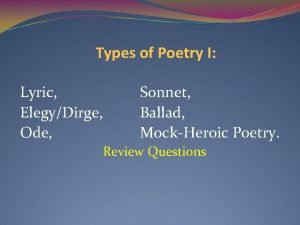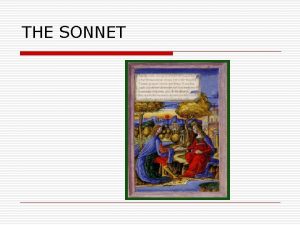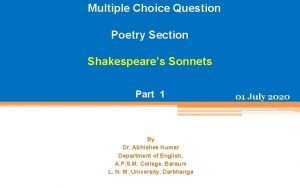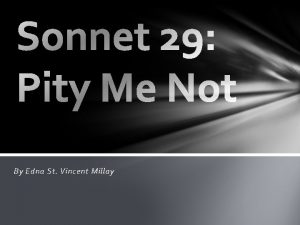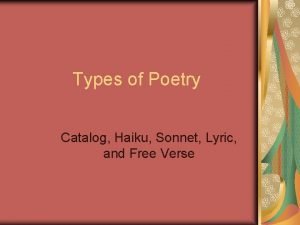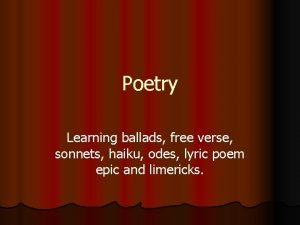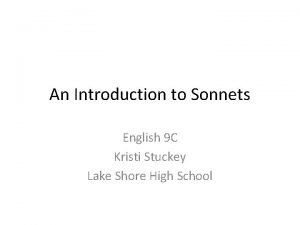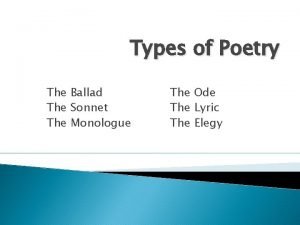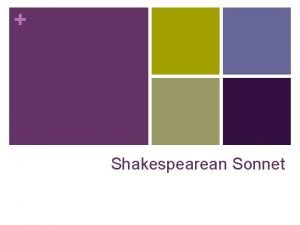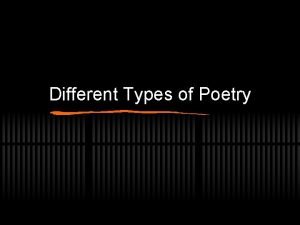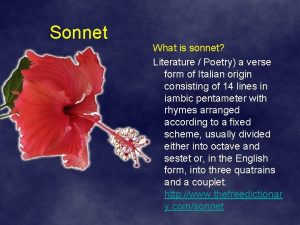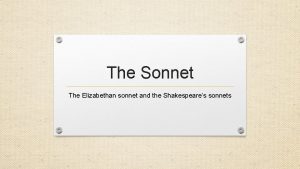The Renaissance Poetry Renaissance poetry the sonnet and














- Slides: 14

The Renaissance Poetry Renaissance poetry: the sonnet and major poets

Rules of Decorum • The rules of Decorum were adopted from ancient Greece and Roman Literatures. • They dictate that a poem has to use a regular form. • Language should be sophisticated/embellished. • Subject matters/themes should be elite/universal truths. • The aim of poetry was to teach/educate and delight/please. • That meant poetry was written by the elite and for the elite. • The rules were “strictly” followed during the Elizabethan age, 17 th and 18 th centuries.

The Sonnet • Poetry developed substantially during the Renaissance at the level of form and theme. • Poems are no longer narrative nor long. • The major form of poetry during the Renaissance is known as the sonnet. • The sonnet is not an original English form of poetry but it is Italian. • The first sonnets of English were named Petrarchan after the Italian poet Petrarch.

The Sonnet • They were 14 -line ten-syllable poems that had two main stanzas the octave (the first eight lines) followed by the answering sestet (the final six lines). • The rhyme scheme of Petrarchan sonnet was abba cdecde (or cdcdcd). • The argument/problem of a poem was presented in the octave in Italian sonnet, and the solution was at the sestet after a turn called Volta. • Sir Thomas Wyatt was the first to introduce the sonnet into English as mere translations of Italian sonnets.

The Sonnet • Henry Howard, Earl of Surry, tried to develop the Italian sonnet to seem English. • The sonnets of Thomas Wyatt and Henry Howard were published between the 1530 s and 1540 s in an anthology called Tottel’s Miscellany. • Some poems like Edmund Spenser tried to develop the sonnet, but the most recognized contribution was Shakespeare’s.

The Sonnet • New themes like courtly love, regeneration and rebirth, the mutability of life, and death started to emerge in poetry. • Elizabethan or English sonnet is a 14 -line ten-syllable poem written in iambic pentameter. It has three quatrains and a rhyming couplet. • A quatrain consists of four poetic lines.

Shakespearian sonnets • Shakespearian sonnet is divided into three quatrains and a rhyming couplet. The resolution of the main argument is introduced in the couplet. • So, Shakespeare developed the Italian sonnet. • The rhyme scheme of Shakespearian sonnet is abab, cdcd, efef, and gg • Major Shakespearian themes: platonic love, passage of time, and death.

Sonnet 144 Two loves I have of comfort and despair, Which like two spirits do suggest me still The better angel is a man right fair, The worser spirit a woman coloured ill. To win me soon to hell, my female evil Tempteth my better angel from my side, And would corrupt my saint to be a devil, Wooing his purity with her foul pride. And, whether that my angel be turn’d fiend, Suspect I may, yet not directly tell, But being both from me both to each friend, I guess one angel in another’s hell. Yet this shall I ne’er know, but live in doubt, Till my bad angel fire my good one out.

Sir Philip Sidney 1554 -1586 • The first major poet of the Renaissance was Sir Philip Sidney 1554 -1586. • He was an ideal Renaissance figure: a man, soldier, a man of learning, and a romantic lover. • Sidney died young at 32. That created a romantic image of him. • Astrophel and Stella is full idealized love for Stella but the poet can never have her.

Sir Philip Sidney 1554 -1586 Leave me, O Love, which reachest but to dust; And thou, my mind, aspire to higher things; Grow rich in that which never taketh rust; Whatever fades but fading pleasure brings. üWhat is theme in these lines? üHow does the poet reflect the spirit of Elizabethan poetry in these lines?

Edmund Spenser (1552 -1599) • Spenser was known as the Prince of Poets in the Elizabethan Age. • He was a controversial figure: someone with new ideas or a writer who tried to please/flatter his superiors. • He wanted to take his place in the English tradition of poetry like Chaucer. • The Faerie Queen (the 1590 s) is his great national epic to celebrate Queen Elizabeth for the sense of national identity it communicates.

Edmund Spenser (1552 -1599) • He used a new verse form of stanzas on 9 lines rhyming ababbcbcc. It was an attempt to develop the Italian sonnet. • The Faerie Queen is the most important poem in English since Chaucer. • It celebrates Queen Elizabeth as Gloriana, the national heroine who brings peace and wealth to the nation. Sweet Thames! Run softly, till I end my song. This line, from “Prothalamion” (1596), is one of Spenser’s best -known lines.

Marlowe as a poet • Most of the playwrights of the Elizabethans and Jacobean age wrote poetry as well as plays. • However, they did not publish their works but showed them to a small circle of friends and admirers. • So, many poets who are now regarded as the great poets of the Jacobean age were not very well known as poets during their lifetime

Marlowe as a poet Come live with me and be my love. And we will all the pleasures prove. (The Passionate Shepherd to His Love)
 Sonnet vs ode
Sonnet vs ode Petrarach
Petrarach Sonnet poem
Sonnet poem Sonet renesance
Sonet renesance Sonnet 29 poetry prof
Sonnet 29 poetry prof Multiple choice questions on shakespeare sonnets
Multiple choice questions on shakespeare sonnets Sonnet 43 edna st vincent millay
Sonnet 43 edna st vincent millay Italian sonnet examples
Italian sonnet examples Poems with literary devices highlighted
Poems with literary devices highlighted Free verse haiku
Free verse haiku Sonnet rules poetry
Sonnet rules poetry Is sonnet 18 a lyric poem
Is sonnet 18 a lyric poem Sonnet and ballad
Sonnet and ballad Introduction to sonnets
Introduction to sonnets Outcome of renaissance
Outcome of renaissance
